How to choose and install a cabin hook
The cabin hook is the Cinderella of shed door hardware. Unlike the hinges, locks and door handle they are often added as an afterthought. Spending a little time selecting the right type of cabin hook, made from the correct material, of the right length and with a little thought to the fixings can make using your shed a lot more enjoyable.
It might seem really basic, but spending a few moments looking at the range of options available will help you to choose the right cabin hook from the get go.
What are the parts of a cabin hook?
There are three basic parts to a cabin hook:
- The cabin hook
- The cabin hook eye
- The fixings that secure the cabin hook and eye to the door and the wall
When you buy a cabin hook from your hardware supplier it will sometimes be supplied with fixings, but it is worthwhile considering if they are right for your situation. I will describe a bit more on the things to consider when I describe how to install your cabin hook further on.
What materials are cabin hooks made from?
Cabin hooks are made from a variety of materials. I have installed cabin hooks made from brass, stainless steel and mild steel. They come in a variety of finishes. You need to think about the finish especially if you are using steel cabin hooks as if they don't have a good protection system they will be liable to rust. Which is unsightly and can cause staining to the cladding of the building.
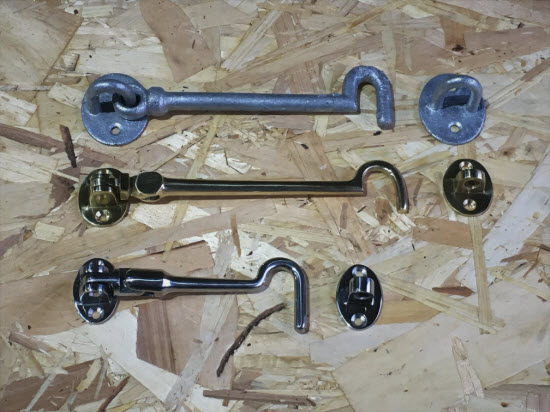 3 Types of commonly available cabin hook. From the top: Galvanised, brass and stainless steel
3 Types of commonly available cabin hook. From the top: Galvanised, brass and stainless steel
Corrosion protection to steel cabin hooks is either a galvanised finish or painted. Galvanised cabin hooks are pretty corrosion resistant as the coating is sacrificial and even when scratched the zinc corrodes in preference to the steel beneath. However, the plain painted cabin hooks are liable to rust once the protective paint has been scratched off where the cabin hook attaches to the eye and also where the cabin hook is attached to its own swivel.
What designs of cabin hooks are there?
The basic cabin hook is just a hook with an eye. The problem with this very basic design is that no particular thought has been given to how the cabin hook fits in to the eye. This means that if the wind is gusty you may notice that the door rattles a bit due to the tolerance of the hook fitting in to the eye.
Silent Pattern Cabin hooks reduce the problem of the door rattling
The development of the silent pattern cabin hook relates to the origins of this piece of hardware on boats where the movement of a door back and forth with the movement of the boat would resound throughout the whole boat and very quickly contribute to Cabin Fever!
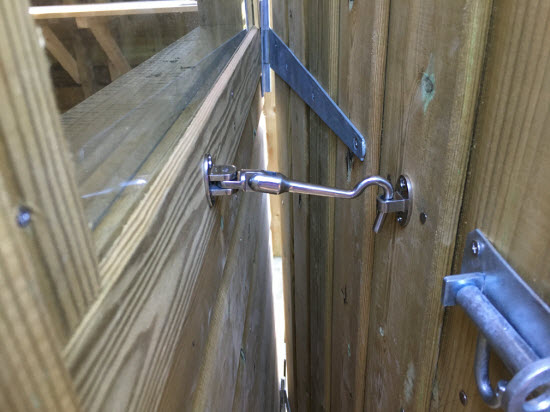 Stainless steel silent pattern cabin hook
Stainless steel silent pattern cabin hook
The hook and eye in a silent pattern cabin hook are designed to be a lot closer tolerance so if the wind is gusty then the door doesn't blow back and forth causing slight movement and rattling sound. Also, the shape of the hook and eye have been designed and machined so that as the door moves slightly back and forth the cabin hook doesn't 'pop' out of the eye.
But bear in mind that due to the closer tolerances and design that silent pattern cabin hooks are generally more expensive than your run of the mill design. Also most cabin hooks don't need to be silent pattern as they are used in fairly still wind conditions.
The length of the cabin hook is important
Cabin hooks come in a variety of lengths from the short, at about 4 inches (0.1m), to long at 2ft (0.6m). There is a bit of flexibility with the length of cabin hook you choose, as the door folds back it gets closer to the wall.
However, don't be too carefree with this, check that the door folds fully back against the wall if you are going for the shortest cabin hook. Sometimes the door doesn't fully fold back as some part of it may bind against the door frame.
In this example on an octagonal summerhouse the side wall is angled back from the line of the front wall. In this case a cabin hook that was too short, was made to work by adding a wooden block to pack out the cabin hook.
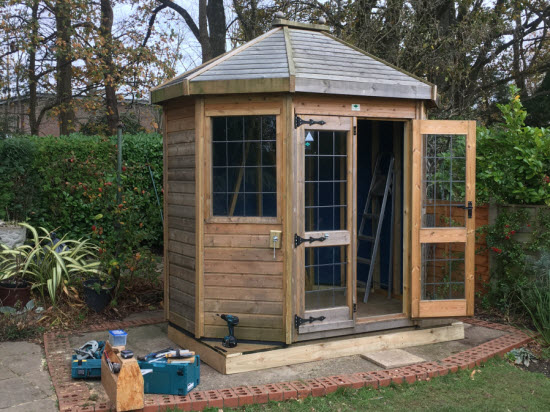 The cabin hook used in this example should have been longer to avoid the use of the 'packing block'
The cabin hook used in this example should have been longer to avoid the use of the 'packing block'
The length of the cabin hook is also decided by the angle you want to secure the door. Shorter cabin hooks are needed if you can swing the door through 180 degrees so that the door is flush against the wall.
Longer cabin hooks are needed if you want to hold the door at 90 degrees. It is also likely that the door will experience stronger forces when it is kept open at 90 degrees as more area is exposed directly to the wind.
Now you know what details to look for when buying a cabin hook lets take a look at what you need to know when installing your cabin hook.
Should a cabin hook be fixed to the door or wall?
Firstly, in my view the cabin hook should be fixed to the wall and the eye to the door.
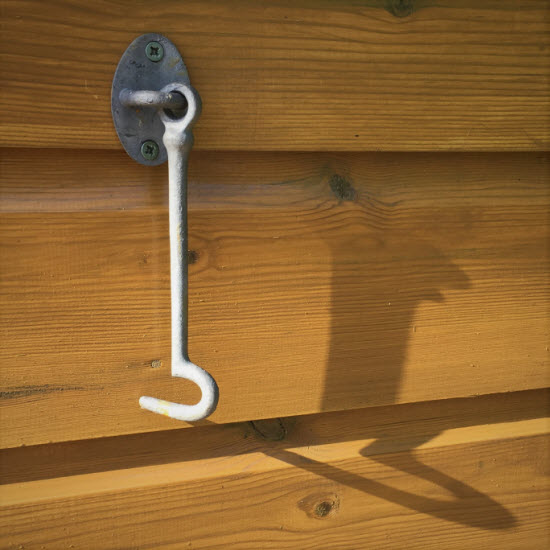 The hook fixes to the wall
The hook fixes to the wall
This is because the door moves and the wall doesn't. A dangling cabin hook fixed to the door scuffs the paintwork, every time it is open and shut making an ugly mark. So, get it right fit the cabin hook on the wall and the eye on the door.
Try and fix the whole installation as far from the hinges as you can. This means that the forces on the cabin hook and hinges will be less when the wind catches it. This means that there is less likelihood of damage to the fixings securing the cabin hook or strain on the door hinges.
In general, you should try to fix the cabin hook in the last 25% of the door. So, for a 2 ft (600mm) wide door the cabin hook should be 18 inches (450mm) or more away from the hinge.
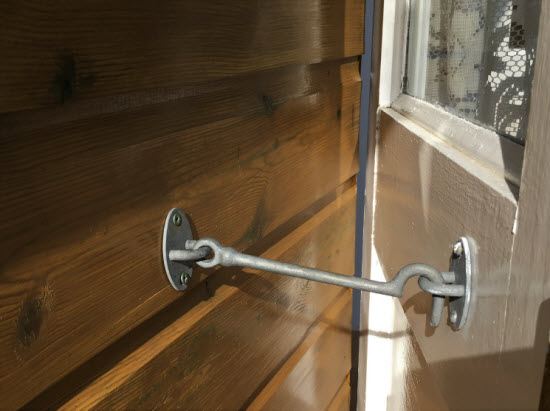 Well positioned cabin hook
Well positioned cabin hook
There are generally good fixing points at the bottom, middle and top of a door, coinciding with main structural sections in the door. Fitting the cabin hook to the one in the middle is the most solid position but you may have a specific reason for wanting to fit the hook at the top or bottom. Generally, each position is acceptable unless you are subject to really strong or gusty winds.
In terms of the order of installation. I would say it is better to fit the cabin hook eye first. You generally have greater freedom of where to fit the actual hook on the wall than on the door. But it is worth while checking this applies to your situation.
This brings us neatly on to the fixings for the cabin hook.
How to fit a cabin hook
Many cabin hooks are supplied with screws don't necessarily use these fixings. Many pieces of hardware are supplied with cheap fixings or ones that aren't long enough for your purpose, so you may be better supplying your own.
If you are fixing a cabin hook to a shed then try to locate the hook and eye such that you are fixing in to the door frame or an element of the shed frame. If you fix into a thin section of cladding the screws may protrude through to the other side (causing a scratch hazard) and they may even pull out or weaken the fixings of the cladding.
If necessary use longer screws than those provided to make sure you get through the cladding and into some solid timber beneath.
It is worth checking that the screws supplied are suitable for external use. Internally rated screws will corrode and causing brown rust stains fairly quickly. Use either stainless steel screws, brass screws or screws coated for external use (often marketed as decking screws).
Fixing to timber is fairly straightforward but fixing a cabin hook to uPVC windows or doors often flummoxes people.
Fixing a cabin hook to UPVC doors
Fixing a cabin hook to uPVC doors is fairly straight forward. I asked the person who installed my patio doors and he showed me how. He also told me that doing so would invalidate any guarantee from the manufacturer! Anyway 5 years on the cabin hooks and the doors are doing just fine.
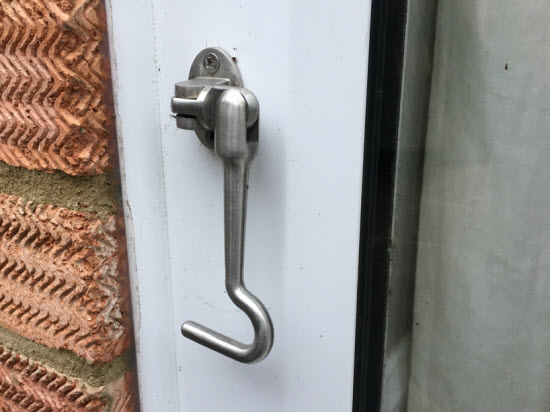 Cabin hook fixed to uPVC door frame
Cabin hook fixed to uPVC door frame
The obvious points to note are drill far enough away from the edge of the frame that you don't go anywhere near the double-glazed unit!
Also, be aware that beneath the uPVC there may be some thin steel sections to reinforce the door. In case you come across steel use a High-Speed Steel (HSS) drill bit that will drill through steel. The drill bit size that you use should be 1mm smaller than the screw size that you use. So, for a 4mm screw use a 3mm drill bit etc.
Brass screws wont work here as the screw won't cut through any steel reinforcement and you will just damage the head of the screw. Also, preferably use a manual screw driver as using your drill/driver is likely to strip the thread you have cut as you tighten the screw up.
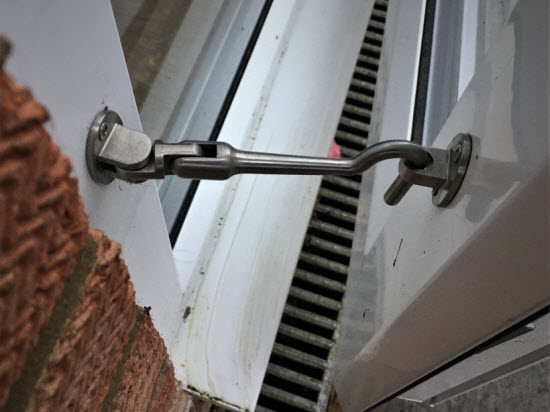 Cabin hook holding uPVC door in place
Cabin hook holding uPVC door in place
Finally, to ensure that you don't compromise the water resistance of the door section. Apply a small amount of silicone sealant on to the back of the cabin hook or eye before fitting. Making sure to wipe off any excess immediately.
Conclusion
Choosing the right cabin hook should now be straight forward. Make sure you get a decent quality corrosion resistant piece of hardware. A silent pattern cabin hook will give you less door movement if that is important to your situation.
Make sure you know what position you would like to hold your door in and where on the door you are going to fit the cabin hook so that you can choose the correct length.
Don't feel obliged to use the fixings that are supplied with the cabin hook. Use longer ones to make sure if necessary to get a fixing into something solid.
Cabin hooks can be fitted to all sorts of materials including wood, uPVC and brickwork.

Looking for more information on how to get your shed door working perfectly?
Return from Cabin Hook to the Shed Door Hardware hub page

Keep in touch with our monthly newsletter
Shed Building Monthly



